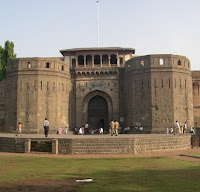 |
| Mumbai |
 |
| Pune |
Vs.
Recently I had a chance to visit Mumbai for my GRE. People around me might be aware of the fact that I detest Mumbai to some extent for being sultry, humid and overcrowded. But during this visit, I had a realization of some other notable aspects of Mumbai that you can never have in Pune. Some things that make Mumbai more of an attractive place to live than Pune. These are some of my observations along with some known facts about Mumbai and Pune.
Mumbai: Very humid, sweltering climate in almost all seasons
Pune: Pleasant climate... dry and cool air
Mumbai: Extremely crowded
Pune: Moderately crowded (can be seen as advantageous or otherwise)
Mumbai: 4 wheelers
Pune: proliferation of 2 wheelers
Mumbai: People follow lane discipline while driving (looks so cool)
Pune: What's a lane? :P
Mumbai: People speak Mumbaiya - a unique variation of Hindi
Pune: People insist on speaking Marathi... and only the Puneri version of it... which (according to them) is the purest form of Marathi.
Mumbai: Very helpful people
Pune: The old city often gives you some experiences of "ear-pleasing" conversations with native people.... sometimes even swear-words... and the Marathi ones... BEWARE
Mumbai: If you see a plate "Beware of the dog" outside houses, do beware of the dog.
Pune: Ignore such plates... they are just a threat to keep unwanted guests away. There may not even be a dog in the house. But you still should beware of the plate (paati) owner who may frown at you for ignoring the Paati.
Mumbai: People willingly help you to locate new addresses.
Pune: I often hear this story of how some guy asked for an address in some random house on a street in Kothrud and he was shown the directions by the woman "इथून थोडं बाहेर जा... खालच्या अंगाला वळा... तिथे या इमारतीचं गेट दिसेल... त्यावरची पाटी वाचा.. (येथे पत्ते विचारू नयेत.)" :-|
Mumbai: People are courteous.
Pune: People write Puneri Paatya for deliberately insulting you. There is even a website for such Paatis. www.puneripatya.com. Some of them we discussed in preceding points.
Mumbai: Local trains are the fastest way of traveling. These trains work at clockwork precision. You will have another train after exactly 3 minutes if you miss one. GPS control... you see.
Pune: Our old PMPML :P .... no need to mention the details of how "efficient" they are. You miss one and you might have to wait for another half an hour :)
And don't even think about local trains. I have seen Pune-Mumbai trains being more frequent than Pune's local trains.
Mumbai: A sea... wow
Pune: A couple of rivers full of dirt (I don't know why puneites are proud of them)
Mumbai: No winters :(
Pune: chilling... I love it.
Mumbai: I would love to drive on those roads.
Pune: It is always a sweating experience for newbies.
Mumbai: Good chaat outlets
Pune: Don't even get me started on Pune's chaat... Come on... Chaat is not supposed to be sweet.
Mumbai: I would love to drive on those roads.
Pune: It is always a sweating experience for newbies.
Mumbai: Good chaat outlets
Pune: Don't even get me started on Pune's chaat... Come on... Chaat is not supposed to be sweet.
Well, I am not biased or anything. I don't hail from any of these cities. Hence, I think my perspective is neutral. I love both of these cities for being one of their own kind. More on my home town in later posts...




